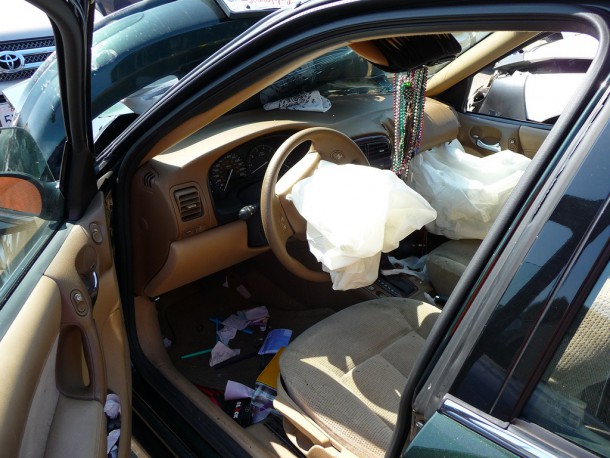How Are Deployed Airbags Repaired?
Posted on Apr 18, 2018 in Editorials | 1 comment

We discussed the general process of repairing a salvage car a few weeks ago and one commenter asked about airbags. Joe Btfsplk writes:
How do you deal with deployed airbags? Are used parts allowed to be used in salvage vehicles? This seems to get little attention in the article.
Dealing with deployed airbags in modern cars can be a tricky and costly situation. The installation of used parts is allowed but may not always be the safest solution.
Cars with deployed airbags are a common sight at salvage auctions. New airbags are expensive and repair costs pile up quickly. This can quickly write-off a vehicle in the eyes of insurance companies. My experience with buying salvage cars included those that had frontal airbag deployment, but I avoided buying cars with deployed side or seat airbags as they were usually a pain to fix.
There are a multitude of ways to repair deployed airbags, starting from the most expensive option of replacing all the damaged parts with new components, down to the most illegal option of just replacing airbag covers. My method of repairing these cars was centered on a mixture of new and used parts that resulted in a safe and cost effective repair.
I wrote about repairing a 2005 Cadillac STS last year and the costs involved. It arrived from the auction with a blown driver and passenger airbag, resulting in a broken dash. The other items that needed to be replaced included the clockspring behind the steering wheel, the airbag module and the seat belt pretensioners.

These items commonly deploy together due to the way safety systems are programmed. In a front end collision, the front crash sensors react by sending a signal to the airbag module. The module then sends a signal to the airbag to deploy and the pretensioner to tighten the seat belt. During the process of this deployment, the clockspring behind the airbag often gets damaged from the force of the deployment.
Checking some discount GM parts websites shows a cost of about $1,600 for new versions of all of these parts, excluding the dashboard. This is a somewhat reasonable cost, but used parts are still an option and, in the case of my Cadillac, they can reduce repair costs significantly. One junkyard in the area had an STS that matched the one I was repairing almost exactly, and they offered to sell the whole package of parts for the low price of $400. This included the dashboard and all of the airbag components except for the pretensioners. I found the pretensioners on eBay for about $80. Once the parts were installed, I had a friend come and program the airbag module to the car.

Most of the cars I repaired followed a similar procedure and finding good used parts was the goal. Some vehicles required new replacement parts if I could not find trustworthy used units. Used airbags and safety components are not heavily regulated so parts quality can be questionable. Some junkyards remove airbags and components and store them in a clean and dry area once the cars arrive; others are happy to let cars sit out in the rain with broken windows, which can cause moisture to enter the components — and we all know what’s going on with Takata right now. Inspecting used airbags is very important since they might look good on the outside but might be a ticking time bomb on the inside.
Even if a used airbag checks out as a good unit and doesn’t show signs of moisture, it might still be unsafe to use. The airbags involved in the Takata recall are still being sold by some junkyards even though they have been deemed unfit to use. Honda is working on removing these faulty parts from the market by reaching out to junkyards and offering to buy them. One of the largest used parts databases, car-part.com, has also stepped up in recent months to help curb the resale of these faulty parts by removing the affected parts from its database. These are steps in the right direction, but many of these parts can still be bought directly from junkyards by unsavory figures.
Recalled airbags are becoming a smaller problem due to the efforts of the manufacturers and recycling industry, but counterfeit and modified bags are still not under control. These airbags are non-operational and illegal but still get installed by rebuilders looking to scam their customers and sell them unsafe vehicles. They buy replacement airbag covers from China for $10-15 each and remove the deployed components. Once the new airbag cover is glued into place, it appears as if it’s been replaced by a properly functioning unit. They work around the warning lights by removing bulbs, painting over them, or installing resistors in order to fool the airbag system.
These modified systems are very dangerous so it’s important to check. It’s also one of the reasons I no longer buy rebuilt salvage vehicles. If you must buy a rebuilt vehicle, I recommend checking the seat belt pretensioners as the first step. Once they are deployed, they will cause the buckle to sit lower than normal because of the action that pulls down the seat belt. If they check out, I recommend getting an inspection of the system by a technician with an OEM airbag scan tool.
Rebuilt cars that have suffered an airbag deployment are a gamble and the used or counterfeit parts that can be found in some can be deadly. Careful inspections are of the utmost importance.





.gif)


That’s the reason why I would never buy a rebuilt car, but would rebuild myself. There is no way to fully test an airbag other than deploying it. If the module is happy, there are no other tests. I would always replace airbags with a new part. All the cosmetic stuff like the dash, used is fine.